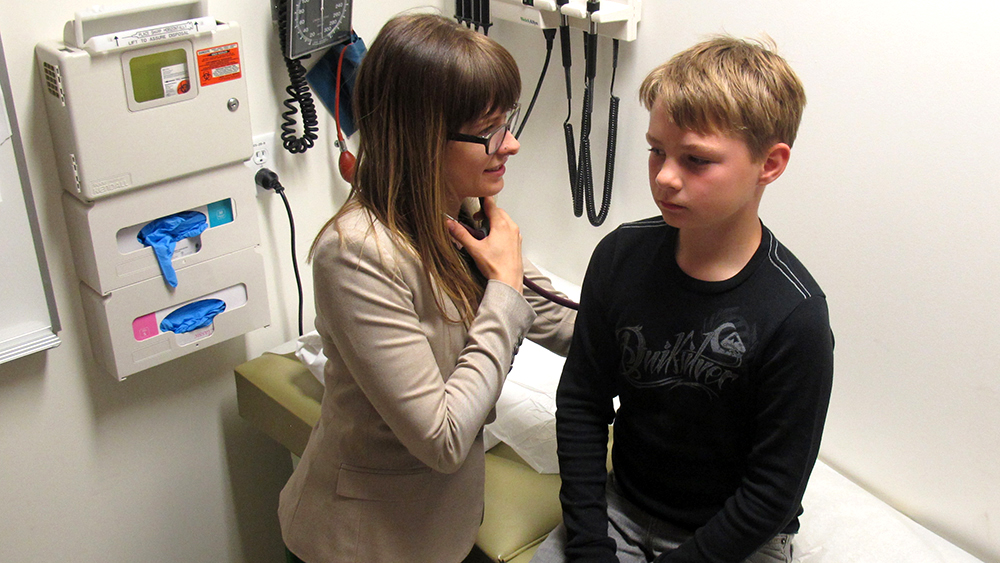
Bailey Adams is one of 74 medical graduates from the class of 2014 who will specialize in family medicine.
Bailey Adams didn't come to her decision to be a family doctor in small-town Alberta lightly.
"One of the reasons why I was interested in participating in the UAlberta programs that focuses on practice in rural communities was because I was hoping I would discover I didn't like being in a small town," laughs the native Edmontonian, who is preparing to join a family medicine clinic in Grande Prairie through UAlberta's Department of Family Medicine.
The move by fledgling physicians to become family doctors is becoming increasingly evident, as a record number of medical graduates are listing family medicine as their first residency choice. Of the 170 medical students graduating this spring, more than 43 per cent have chosen to become family physicians. That number has more than doubled in the last decade. And, more and more, the number of MD graduates practicing family medicine in rural communities as residents is on the rise, thanks to programs offered through the Faculty of Medicine & Dentistry (FoMD).
Adams' journey from big-city student to rural doc started with the Preclinical Networked Medical Education (PNME) program in her second year, when she spent a month in Peace River. The PNME program began in 2011 as a pilot project that allows students to take a component of their studies in a rural clinical setting, which gave Adams exposure to daily clinical work for the first time. "I really like the variety of clinical exposure," she says, and that her positive experiences with the PNME program whet her appetite for rural practice. In her third year, Adams participated in the Integrated Community Clerkship (ICC) Program in Hinton, under three primary preceptors who had graduated from the UAlberta rural residency program in Red Deer two years earlier. The confidence they had in their competencies after being part of a rural program stuck with Adams.
"Being in the ICC program helped me develop important mentor relationships with the preceptors, which, in turn, helped me build confidence in my decisions around treatment planning. It provided me with a good, well-rounded education," she says. "The ICC Program gave me access to learning a variety of care and exposed me to important patient interactions."
Fraser Brenneis, vice-dean, education, in the FoMD, is gratified that Adams and students like her have benefitted from rural clinical exposure through the ICC Program, which began in 2007. It places third-year medical students in rural communities to work with family doctors for 41 weeks. ICC program participants' results show that approximately three of four choose a career as a family doctor, with almost half caring for patients in rural communities.
"The ICC is an important element of the Family Medicine Residency Program," says Brenneis. "Programs like these are undeniably impactful in exposing students to opportunities to see, live and train in a rural community and to imagine themselves being able to do the work."
The chance for trial runs at rural medical practice during med school is important to guiding the long-term decisions students make when entering residency, says Lee Green, chair of the Department of Family Medicine in the Faculty of Medicine & Dentistry.
"Students are having the opportunity to actually see what family medicine is like much earlier in their education, and realizing what it's really like," he says. "It's endlessly challenging and interesting, and we family physicians develop strong and rewarding relationships with our patients. That's appealing to students."
The decision to practice in a rural community can be especially rewarding, says Green. "Rural family medicine offers physicians the opportunity to practice a very wide range of skills, to use all their learning and their abilities. It's very stimulating and interesting. Rural family medicine also offers a sense of community, of belonging, that makes it a great place to live and to raise a family. Rural communities value their family physicians highly."
For Adams and her 73 fellow classmates choosing to become family doctors, the chance to advance the health of rural Albertans through teaching, research and patient care is a privilege. Her medical bag is packed and she begins work in Grande Prairie on July 2.